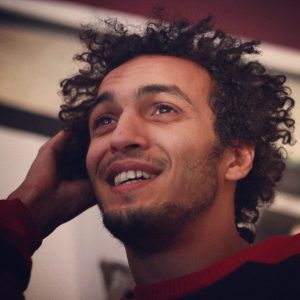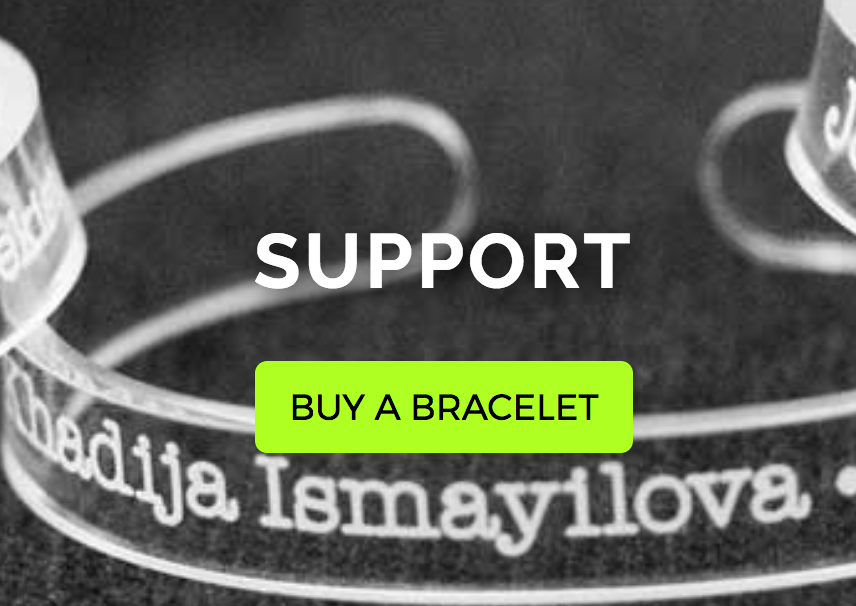More Than 1,000 Days Later, Still No Trial for Imprisoned Egyptian Photojournalist
The morning of Aug. 14, 2013, started out quietly. After more than 40 days camped out in Rabaa al-Adawiya Square in Cairo, pro-Muslim Brotherhood protesters were beginning the hot summer day with morning prayers and pick-up soccer, remembered Mike Giglio, an American reporter who was covering the anti-government sit-in for Newsweek magazine.
But when Egyptian security forces arrived, they shot tear gas canisters and fired automatic weapons into the crowd. Video footage published by Human Rights Watch showed streets strewn with blood and the air engulfed in smoke. By day’s end, at least 817 protesters had been killed and more than 800 arrested.
Mahmoud Abou Zeid, an Egyptian photojournalist who goes by the nickname “Shawkan,” had arrived at the sit-in at 5 a.m. with his colleague Louis Jammes, a French freelance photographer. They were taking photos when they got news that security forces were going to disperse the protest, and Abou Zeid convinced Jammes to move behind police lines to photograph it from the outskirts, Jammes said in an interview over Facebook messenger.
“Shawkan, like his friends, like a majority of Egyptian people, trust the army,” wrote Jammes.
But an hour later, when Abou Zeid and Jammes continued to document the scene from outside the police line, Egyptian Central Security Forces arrested them and confiscated their equipment.

Shawkan was sitting in Cairo Stadium with his hands tied hours before a police officer was murdered that day, a crime he is charged with
Credit: Free Shawkan Campaign
The timeline is critical because Abou Zeid is being accused, along with 738 protestors, of murdering a police officer and setting a mosque on fire, events that occurred hours after he was in police custody, according to a petition submitted to the U.N. Working Group on Arbitrary Detention by the Impact Litigation Project at American University Washington College of Law.
Now, more than 1,000 days later, Abou Zeid remains behind bars, in deteriorating mental and physical health, and with little progress toward the resolution of the case, according to interviews with sources working closely on his case, some of whom requested anonymity for their safety.
The 28-year-old photographer is suffering from complications related to hepatitis C and anemia, which have gone untreated in prison, according to Ahmed Abu Seif, a childhood friend who runs the “Freedom for Shawkan” campaign.
“Shawkan… should be taken to the hospital immediately,” said Abu Seif in an email interview with Capital News Service. “His condition is worsening because he has no access to medical treatment. He vomits and has frequent fainting fits.”
One of Abou Zeid’s lawyers said he is also suffering mentally. “Some of his relatives think he may commit suicide,” Karim Abdelrady wrote in an email to CNS. “All the time he says he wants to be free because he is going into pieces.”
After several delays, the photojournalist is supposed to stand trial soon with 738 other defendants facing life imprisonment or the death penalty for their participation in police killing, mosque burning and the Rabaa al-Adawiya Square protest that day.
A young photojournalist
Abou Zeid left his home in Kuwait in 2009 for Egypt to become a photojournalist, according to Abu Seif. Abu Seif called him “a talented photographer” who became a photojournalist because he preferred photographing reality as opposed to objects or models.
“He loved his work to death,” wrote Abu Seif.
Abou Zeid has worked as a freelance photographer for publications such as Time Magazine and Demotix, a London-based online photo agency. He was on assignment for Demotix the day he was arrested.
Images in the “Personal Favorites” section on Abou Zeid’s recently closed website, shawkan.com, showed his interest in anti-government protests that have been frequent in Egypt over the past five years.
One image shows thousands of people gathered to protest former general-turned-president Hosni Mubarak. In the photograph, taken at night, a mass of protestors with lights twinkling above their heads flood the streets around Tahrir Square.
Another photograph documents a 2013 demonstration against former Muslim Brotherhood President Mohamed Morsi, who was elected to the office after Mubarak was forced out.
The arrest
Abou Zeid was arrested between the hours of 7 a.m. and 9 a.m. on Aug. 14, 2013, according to the U.N. petition from the Impact Litigation Project.
Giglio had been covering the sit-in for Newsweek since 6:30 a.m. and recalled seeing Abou Zeid walk up behind him and remain behind police lines during police efforts to disperse the protesters.
Giglio said the security forces’ violent tactics surprised everyone there. “Nobody knew when it was happening,” Giglio said. “They were threatening it, but people didn’t know what it would look like.”
Jammes, the French freelance photographer, had a contact in the Muslim Brotherhood who permitted him and Abou Zeid to cross into the sit-in earlier that morning to take photographs.
But, he said, Abou Zeid wanted to leave the inside of the sit-in before security forces arrived because he preferred to be near the police. Jammes said he was with Abou Zeid the entire morning until after their arrest.
“I wasn’t [in agreement] but I had no choice to follow him. Because he wasn’t comfortable with the Brotherhood too. He’s Egyptian and not Brotherhood, it could be a problem,” Jammes wrote.
During the dispersal by security forces, Giglio, who had joined Abou Zeid and Jammes, became separated from them. Giglio was arrested around 8 a.m., even after identifying himself as a journalist.
“They punched me and took my laptop,” Giglio said. Security forces then bound his hands with zip ties, put him in a van, and drove him to an arena being used as a holding center.
It was in the crowded prisoner transport van that Giglio was reunited with Abou Zeid and Jammes.
Giglio said the three of them “were leaning together on the floor of this very crowded prisoner transport van” that held around 30 other people.
Security officers ordered the prisoners not to talk and beat those who did, but according to Giglio, who does not speak Arabic. Abou Zeid remained calm and explained to him what was happening.
“The fact that he was willing to take that risk said a lot about him,” Giglio said.
Giglio said he believed that the three of them were in the second group of prisoners to arrive at a sports stadium, which had been turned into a police holding center. But based on the size of the indoor arena and the number of police present, it looked like security forces were preparing for many more.
Giglio and Jammes were held for several hours before being released around noon because they were foreigners.
“We left and he was still there,” said Giglio.
‘The beginning of a crackdown’
In 2012, Muslim Brotherhood party leader Mohamed Morsi narrowly won the country’s first election after the military ousted Hosni Mubarak, who had been Egypt’s president since 1981.
Opposition to Morsi grew when he granted himself overarching power to pass a new constitution while also failing to address economic and social issues. The opposition movement culminated in July 2013 when the military, led by Gen. Abdel Fattah el-Sisi, overthrew Morsi. Sisi is Egypt’s current president.
The Muslim Brotherhood staged sit-ins in Rabaa al-Adawiya Square and al-Nahda Square to protest Morsi’s ouster by the military. Since that time, Sisi’s government has labeled the Muslim Brotherhood a terrorist organization and taken numerous, aggressive measures to suppress free speech and independent journalism in Egypt.
The Egyptian Embassy’s press office in Washington, D.C. did not respond to several email messages and phone calls from CNS seeking comment.
According to the U.N. petition submitted on behalf of Abou Zeid by the Impact Litigation Project, one 2015 anti-terrorism law “can be used to criminalize civil disobedience and control the dissemination of information.” An earlier law, passed in 2013 by interim President Adly Mansour, gives security forces greater discretion in breaking up and banning protests.
Abou Zeid is one of 23 journalists currently imprisoned in Egypt as a result of such laws, according to the Committee to Protect Journalists, a nonprofit organization focused on international press freedom issues. All 23 journalists were jailed after the July 2013 military takeover.
When Abou Zeid “was arrested it was the beginning of a crackdown on press freedom that has now snowballed into a situation in which press freedom is absolutely strangled in Egypt,” said Yasmin El-Rifae, a CPJ research associate who has been working on his case.
Daniel Kurtzer, the U.S. ambassador to Egypt from 1997 to 2001, said the government has cracked down on the media in the name of stability. “The government has argued for these past couple of years, since the summer of ‘13 basically, that these draconian measures are designed to ensure stability and law and order.”
A lengthy imprisonment
After his arrest and initial detainment in Cairo Stadium, Abou Zeid was moved to the New Cairo Police Station where he was held for several days, according to the Impact Litigation Project petition.
He was then briefly detained in Abu Zaabal Prison before being moved to the large Tora Prison complex where he has spent a majority of his imprisonment.
According to a student from the Impact Litigation Project, Tora prison officials have denied Abou Zeid medication for hepatitis C and anemia, conditions he had prior to his arrest.
Citing safety concerns, the student requested anonymity.
Pressure from human rights activists forced prison officials to take Abou Zeid to a hospital for blood work, but according to the student, he hasn’t received any medical treatment.
The 738 other defendants on trial with Abou Zeid were arrested the day police dispersed the Rabaa al-Adawiya Square protesters.
They face life in prison or the death penalty for charges including belonging to a banned organization (the Muslim Brotherhood), terrorism, possession of weapons and explosives, murder and attempted murder, and burning the Rabaa al-Adawiya Mosque.
The mosque was burned during the Rabaa al-Adawiya Square dispersal, and the murder charge involves the death of one of eight police officers who were killed in the riots that day, but hours after security officials had forced Abou Zeid into the prisoner van and brought him to Cairo Stadium.
Students from the Impact Litigation Project and CPJ activists are calling for Abou Zeid’s release, in part because his imprisonment has exceeded Egypt’s two-year pre-trial detention limit.
According to a report from Human Rights Watch, the Rabaa al-Adawiya Mosque did not catch fire until 5:30 p.m., hours after Abou Zeid was arrested and taken to Cairo Stadium.
The U.N. petition from the Impact Litigation Project says Abou Zeid remained in the Cairo Stadium until the next day, when he was transported to the New Cairo Police Station.
Abdelrady confirmed the timeline that the Impact Litigation Project presented to prove Abou Zeid could not have been involved in the murder or the burning of the mosque.
According to Abdelrady, he and Abou Zeid’s other lawyers also presented the court with evidence from Demotix that Abou Zeid was only present at the sit-in because he was on a reporting assignment.
The long wait
Abou Zeid’s trial was initially set for Dec. 12, 2015. It was delayed until Feb. 6 and again until March 26 because, according to El-Rifae at CPJ, the metal and glass cage used to hold prisoners in the courtroom was not large enough to fit all 739 defendants.
According to the Impact Litigation Project’s petition, a judge has renewed Abou Zeid’s detainment every 45 days since his arrest, sometimes without his lawyer present.
He made his first court appearance on March 26, once the defendants’ cage had been expanded. Judges denied his release and deferred the case until April 23 to give the defense lawyers time to examine the prosecutor’s witnesses and documents.
On April 23, when one prisoner failed to appear in court, the trial was delayed again until May 10. On May 10, the trial was delayed until May 17 in order to allow more time for the court to examine evidence. On May 17, the trial was again postponed until May 21. On May 21, judges postponed the trial until May 25, and on May 25, they postponed again until June 28 to allow the court more time to examine the evidence.
Nourhan Magdi, an Egyptian journalist for The Cairo Post who covered Abou Zeid’s first court appearance, described the courtroom in an interview with CNS via Twitter direct messages: “The defendants stood in a sound-proof glass dock supported with a microphone from the inside so the defendants could hear the trial.”
Magdi said that there was intensified security in the courtroom, a factor she attributed to the presence of two prominent Muslim Brotherhood leaders who are co-defendants in Abou Zeid’s trial.
Abou Zeid is being tried in Circuit 28 at South Cairo Criminal Court, the same court that tried three Al Jazeera journalists who were arrested in December 2013. The judge is Hassan Farid, who sentenced the Al Jazeera journalists to three years in prison.
“There was nothing resembling due process, which is why at the end of the trial we were confident we were going to be acquitted, because it was a joke,” said Peter Greste, one of the Al Jazeera journalists who had stood trial and gone to jail, said in an interview with CNS. “We never seriously believed that the judges would embarrass themselves under those circumstances, but clearly we were wrong.”
David Risley, an expert on Egypt’s judiciary who runs EgyptJustice.com, said in an email that the Egyptian version of the Supreme Court, called the Court of Cassation, “has been consistently reversing mass convictions due to violations of Egyptian standards of justice and due process.”
Abdelrady expects the mass trial to last a year or more.
Campaign
About this Site
Pressuncuffed.org seeks to encourage and promote rigorous student reporting, scholarly research and debate on the role of, and obstacles to, independent journalism in the United States and abroad. Our website features reporting by University of Maryland students about press freedom in the United States and abroad. It also offers resources to instructors elsewhere who may want to teach classes or hold workshops on this theme. In the near future, this site will become a place for student work from around the country and abroad.
Dana Priest, two-time Pulitzer Prize winner at The Washington Post and Knight Chair in Public Affairs Journalism at the University of Maryland.


